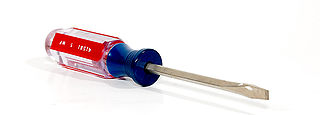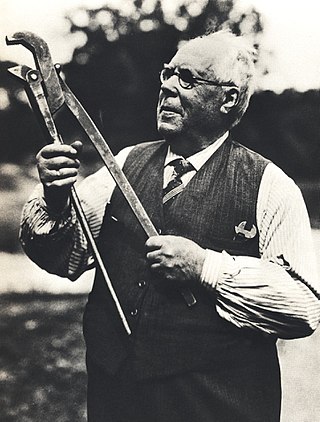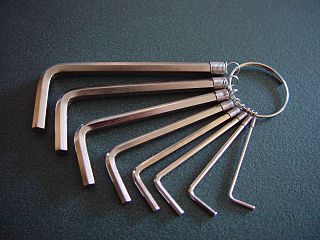
An adjustable spanner or adjustable wrench is any of various styles of spanner (wrench) with a movable jaw, allowing it to be used with different sizes of fastener head rather than just one fastener size, as with a conventional fixed spanner.

A screwdriver is a tool, manual or powered, used for turning screws. A typical simple screwdriver has a handle and a shaft, ending in a tip the user puts into the screw head before turning the handle. This form of the screwdriver has been replaced in many workplaces and homes with a more modern and versatile tool, a power drill, as they are quicker, easier, and can also drill holes. The shaft is usually made of tough steel to resist bending or twisting. The tip may be hardened to resist wear, treated with a dark tip coating for improved visual contrast between tip and screw—or ridged or treated for additional 'grip'. Handles are typically wood, metal, or plastic and usually hexagonal, square, or oval in cross-section to improve grip and prevent the tool from rolling when set down. Some manual screwdrivers have interchangeable tips that fit into a socket on the end of the shaft and are held in mechanically or magnetically. These often have a hollow handle that contains various types and sizes of tips, and a reversible ratchet action that allows multiple full turns without repositioning the tip or the user's hand.

A wrench or spanner is a tool used to provide grip and mechanical advantage in applying torque to turn objects—usually rotary fasteners, such as nuts and bolts—or keep them from turning.

Charles Goodyear was an American self-taught chemist and manufacturing engineer who developed vulcanized rubber, for which he received patent number 3633 from the United States Patent Office on June 15, 1844.
A torque wrench is a tool used to apply a specific torque to a fastener such as a nut, bolt, or lag screw. It is usually in the form of a socket wrench with an indicating scale, or an internal mechanism which will indicate when a specified (adjustable) torque value has been reached during application.
The year 1841 in science and technology involved some significant events, listed below.

A monkey wrench is a type of smooth-jawed adjustable wrench, a 19th century American refinement of 18th-century English coach wrenches. It was widely used in the 19th and early 20th century. It is of interest as an antique among tool collectors and is still occasionally used in practice.

A pipe wrench is any of several types of wrench that are designed to turn threaded pipe and pipe fittings for assembly (tightening) or disassembly (loosening). The Stillson wrench, or Stillson-pattern wrench, is the usual form of pipe wrench, especially in North America. The Stillson name is that of the original patent holder, who licensed the design to a number of manufacturers. The patent expired decades ago. Another type of wrench often used on pipes, the plumber wrench, is also called a pipe wrench in some places.

A plumber wrench is a form of plier described as a pipe wrench that uses compound leverage to grip and rotate plumbing pipes. Similar to the action of a Vise Grip plier, its jaw opening is adjusted to width by rotating a threaded ring. Its advantage is that it grips with significant force without needing to engage a lock nut like an adjustable tongue-and-groove plier. Like these, it can also be used on nuts, particularly hex shaped, and other flat engagement points. If used carelessly it can dent or break plumbing pipe.
Below is a list of events that occurred first in Worcester, Massachusetts.

SK Hand Tools was an American tool company located in Sycamore Illinois. Major products include sockets and drive tools, wrenches, air tools, and other mechanics' tools. The company has a tool line of over 3,500 items including wrenches, ratchets, screwdrivers, tool boxes and air tools. It has manufacturing facilities in Colorado Springs, Colorado and Sycamore, Illinois. Outlets for their products include independent tool-truck dealers, auto parts stores, and major internet vendors such as Sears and Amazon.com.
Daniel Leavitt was an early American inventor who, with his partner Edwin Wesson, patented the first revolver after Samuel Colt's, and subsequently manufactured one of the first American revolving pistols. The innovative design was manufactured only briefly before a patent suit by Colt forced the company to stop producing the Leavitt & Wesson Dragoon revolver. But Leavitt's early patents, and those of his partner Wesson, stoked competition and helped drive the technological and manufacturing boom that produced the modern firearms industry.

A screw and a bolt are similar types of fastener typically made of metal and characterized by a helical ridge, called a male thread. Screws and bolts are used to fasten materials by the engagement of the screw thread with a similar female thread in a matching part.

Francis Blake Jr. was an American inventor.

The United States provided many inventions in the time from the Colonial Period to the Gilded Age, which were achieved by inventors who were either native-born or naturalized citizens of the United States. Copyright protection secures a person's right to his or her first-to-invent claim of the original invention in question, highlighted in Article I, Section 8, Clause 8 of the United States Constitution, which gives the following enumerated power to the United States Congress:
To promote the Progress of Science and useful Arts, by securing for limited Times to Authors and Inventors the exclusive Right to their respective Writings and Discoveries.

Bahco is a Swedish brand within the hand tool industry, which is now part of SNA Europe, part of Snap-on. Its roots go back to the industrial revolution in Sweden in the late eighteen hundreds, starting with innovations such as the pipe wrench and the modern adjustable wrench. Since then, the product range has expanded with a total assortment of products that today includes over 7000 hand tools.

Loring Coes was an American inventor, industrialist and Republican politician who invented the screw type wrench, commonly known as the monkey wrench and who served as a member of the Worcester, Massachusetts City Council and Board of Aldermen, and as a member of the Massachusetts House of Representatives in 1864–1865.
The North Brothers Manufacturing Company, was an American manufacturer based in Philadelphia, Pennsylvania that specialized in the making of hand tools, small appliances and some specialized power tools. They were family owned and operated for over 60 years before being acquired by the Stanley Works in 1946. They are probably most well known for their line of tools, particularly the "Yankee" brand of ratcheting screwdrivers.

A hex key is a simple driver for bolts or screws that have heads with internal hexagonal recesses (sockets).

















